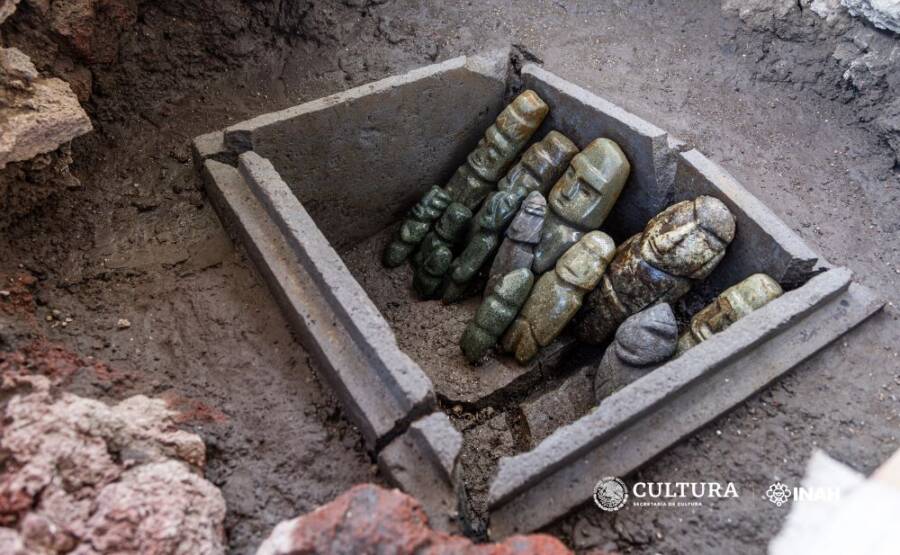Archaeologists discovered the figures in a hidden cache buried at the Templo Mayor in Mexico City, the main temple of what was once the Aztec capital of Tenochtitlan.

Templo Mayor ProjectThe Mezcala-style stone statues recovered as part of the Templo Mayor Project.
A group of archaeologists in Mexico City have unearthed a small cache of human-like stone carvings, likely used by the Aztecs as offerings to their gods.
The team discovered the carvings inside a stone chest at the site of the former Templo Mayor, the main temple of Tenochtitlan, the capital of the Aztec Empire, according to a translated statement.
In all, there were 15 stone effigies discovered — 14 depicting men and a smaller one representing a woman. The largest of the stone statues measures just under a foot tall, with the smallest standing just over one inch tall.
Each was carved from green metamorphic stones, sharing features characteristic of the Mezcala style, a Mesoamerican culture that once inhabited the region of Guerrero.
The Aztecs conquered much of the region in the time of Moctezuma Ilhuicamina, who ruled between 1440 and 1469 C.E. It was Ilhuicamina’s decree that treasures be buried in the “Sacred Precinct of Tenochtitlan” to reflect the wealth of conquered territories.
This has led researchers to believe that the Aztecs valued Mezcala sculptures quite highly.
“This means that, when the Mexicas (Aztecs) subdued those peoples, the figurines were already true relics, some of them more than 1,000 years old, and presumably they served as cult effigies, which they appropriated as booty of war,” explained archaeologist Leonardo López Luján.
According to the Metropolitan Museum of Art, the Mezcala were renowned for their stone works and architectural models, which they produced for nearly a thousand years beginning as early as 500 B.C.E.

Templo Mayor ProjectThe figures were buried in a container alongside several other objects in what researchers think was an offering to Tlaloc, the god of rain.
Many Mezcala architectural models are commonly referred to as temples, but as the Met suggests, some may have been multifunctional. Certain stone objects placed in graves, for example, were believed to serve as entrances to the spirit world, or as dwellings for the deceased.
The Mezcala also aligned with the Mesoamerican tradition of repurposing or re-carving stone objects — a trend that the Aztecs may have continued with their looted goods.
Further evidence suggests that the Aztecs later re-used the Mezcala statues for their own religious ceremony — with facial paint applied to one figure meant to look like the rain god Tlaloc.
Alongside the statues, archaeologists recovered two rattlesnake-shaped earrings, 137 beads of various green metamorphic stones, sea sand, and 1,942 calcareous materials, including shells, snails, and corals. The whole cache was given the designation of “Offering 186” by archaeologists.
This discovery was in part inspired by researchers’ desire to corroborate a pattern found in other offerings — 18, 19, and 97 — which were also found at the Templo Mayor site. Each was a similar stone chest, buried as dedicatory offerings under monumental snake heads.
“In classical Nahuatl, these chests were known as tepetlacalli –from tetl, ‘stone,’ and petlacalli, ‘petate box,'” López Luján said. “In their homes, the [Aztecs] used to keep their most precious belongings in petate chests, such as fine feathers, jewelry or cotton garments, and if we see it from the Templo Mayor… we can imagine the priests storing in these ‘stone flasks’ the quintessential symbols of water and fertility: sculptures of the rain gods, green stone beads, shells, and snails.”
The Templo Mayor project is still underway, and archaeologists believe there are further consecration offerings to be found at the site. The project’s next step is to request authorization from the National Institute of Anthropology and History to remove a snake head statue on the Templo Mayor’s north side so that they may search beneath its base for further caches.
After reading about this new discovery in Mexico City, read about when archaeologists unearthed 119 skulls at an Aztec temple. Or, read the gory legend of Huitzilopochtli, one of the most important gods in the Aztec Empire.





